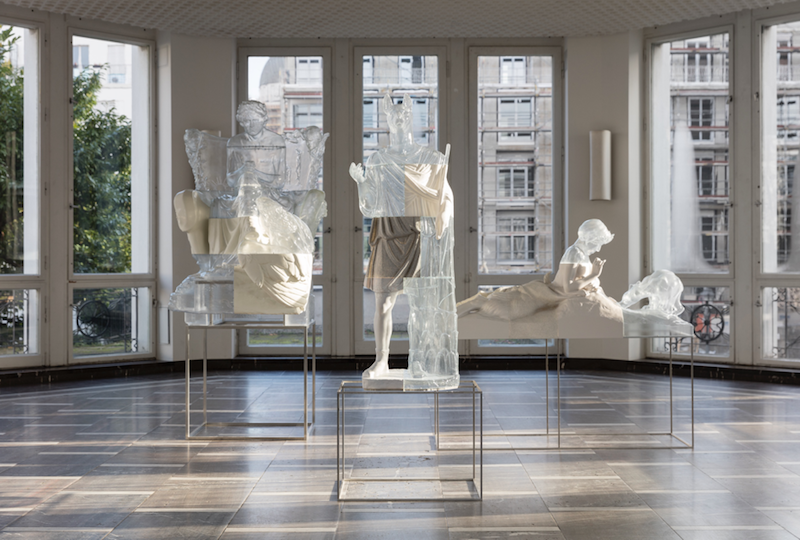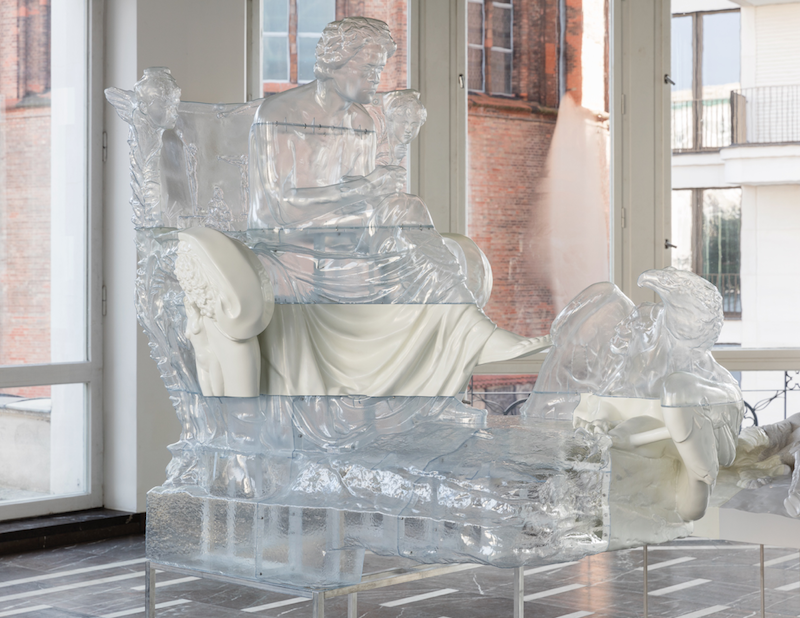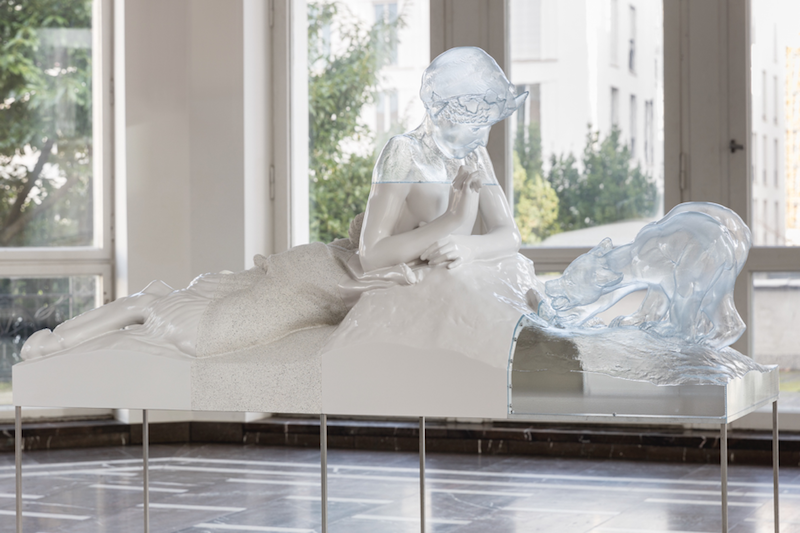Article by Jess Harrison in Berlin // Sunday, Dec. 10, 2017
While Max Klinger’s 1902 Beethoven monument is a solid mass of bronze, ivory and alabaster, the version that stands in Oliver Laric‘s latest show ‘Panoramafreiheit’, has a plasticity that distinguishes it from Klinger’s work, and from the version Laric exhibited at the Vienna Secession in 2016. Assembled from seventeen separate components, the sculptural object at Schinkel Pavillon is a compound of materials and temporality, the joining left visible to mark the schism of the digital age. Though he normally makes use of a 3D scanner to create his models, Laric faced copyright issues from the Museum der bildenden Künste Leipzig (where Klinger’s sculpture is on permanent display) when trying to create this object. This model was therefore manually constructed from hundreds of photographs, the combination of digital technology and the human handmade evident in its imperfections.

Oliver Laric: Panoramafreiheit, exhibition view, Schinkel Pavillon, Berlin, 2017 // Photography by Andrea Rossetti // Courtesy of the Artist and Tanya Leighton, Berlin
Stripped of most of the white resin characterising the version exhibited at his ‘Photoplastik’ show, Laric here employs a translucent materiality that further distances this Beethoven from Klinger’s ivory exterior. There is a hollowness and translucency that evokes malleability, fluidity and a transitional state, embodying Laric’s overarching project. This work and exhibition become another stage in his artistic mirroring of the Internet’s open-source ethics. He is distancing the object further and further away from its “original”, emphasising the mutability of authorship and denying singularity. The object becomes open-ended, its structures free to be modified and authored by whoever wants to. An example of Artie Vierkant‘s ‘Image Object Post-Internet’, the Beethoven in the Schinkel Pavillon possesses no finality. Laric has made all the scans of these sculptures available online at threedscans.com, inviting others to add their agency, creating a cycle of infinite reproducibility and denying any representational fixity. In this digital sphere around which Laric has constructed the works, there exists no copy and original, just variations and versions.

Oliver Laric: Beethoven, 2016, Stereolithography, Aluminum base, 240x107x156 cm // Photography by Andrea Rossetti // Courtesy of the Artist and Tanya Leighton, Berlin
Alongside ‘Beethoven’ stand two other sculptures: ‘Hermanubis’ and ‘Pan with Bears’. Much like the photos in Malraux’s ‘Musée Imaginaire’, they are severed from their historical context and used as signifiers to rethink the parameters of the museum space. ‘Panoramafreiheit’ presents an amalgamation of references to Greek mythology through neo-classical and Roman copies, and 18th century icons, all of which are available to download online. Through this, the objects inhabit several spaces simultaneously and the exhibition extends beyond the octagonal walls of the Schinkel Pavillon. There is an oscillation between the individual and the collective, but always an emphasis on the creation of another version through public accessibility.

Oliver Laric: Pan with Bears, 2017, Stereolithography and selective laser sintering, polyamide, polished epoxy, aluminum base, 144x59x166 cm // Photography by Andrea Rossetti // Courtesy of the Artist and Tanya Leighton, Berlin
Through the scanning technique Laric flattens layers of creativity, originality, intellectual property and any sense of artistic aura that Benjamin outlined in his influential essay on mechanical reproduction. Fifteen years of Max Klinger’s manual effort becomes sets of data held on a screen to be dispersed with infinite possibility. Laric removes any veneration that can be associated with the singular site of Klinger’s sculpture, performing a form of iconoclasm for the digital age.
‘Panoramafreiheit’ uses digital strategies to create sculptures that exist in the real world. Through a duality between the virtual and the tangible, Laric presents us with relics of the future. These objects signify a move to an artistic state where all our monuments and all our icons are kept online as downloadable scans, free to the public domain. The physicality of the exhibition, however, indicates we are not there yet and that an effort to apply the open-source ethos to all aspects of culture must remain ongoing.
Exhibition Info
SCHINKEL PAVILLON
Oliver Laric: ‘Panoramafreiheit’
Exhibition: Dec. 02, 2017 – Jan. 21, 2018
Oberwallstraße 1, 10117 Berlin, click here for map





















